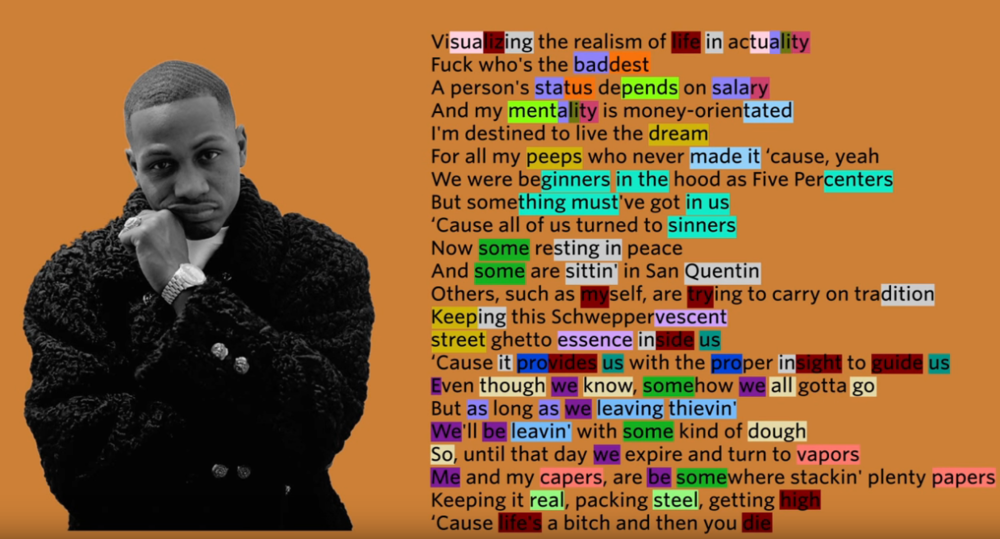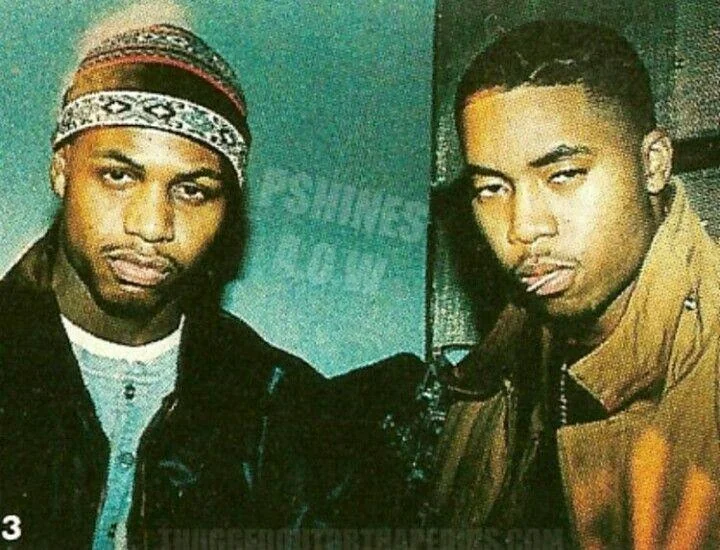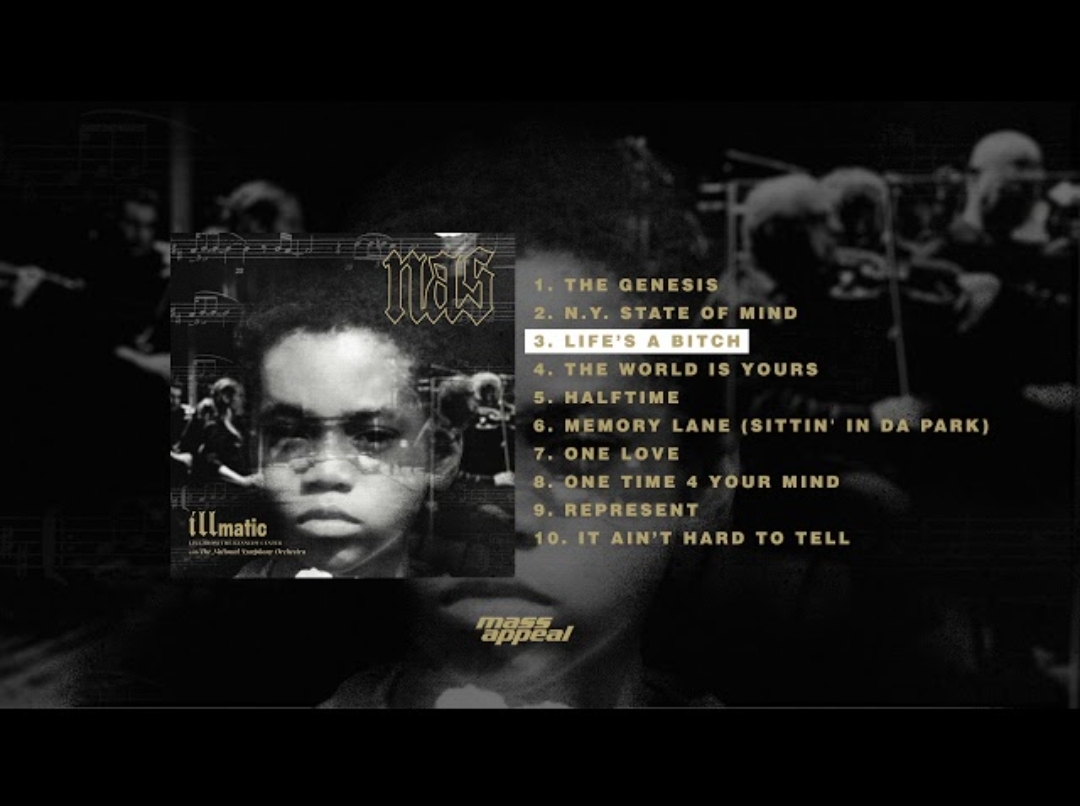Some might find it odd that I’d post this after being in the new year. I completely get that, but technically we are still within the birth-year of the album. Illmatic doesn’t turn 31 until April, and I still have a lot to say about it; so, I intend to see this series about what I feel to be a monumental musical recording through to completion. Here’s to picking back up…
With the third track on Illmatic, Nas followed up N.Y. State of Mind with another classic that would shift the landscape of Hip-Hop. Track 3, Life’s A Bitch is a profound coming-of-age statement conveyed as effectively as any in art in a way that couldn’t be delivered with more impact outside of the way in which this song does uniquely. This song’s premise would grow into entire album concepts for others to come and helped to launch the career of an all-time great rapper in his own right. It would also further establish Nas as a lyrical acrobat worthy of the praise he’d received in his career to that point.
Life’s A Bitch brought us a different Nas. If you’d only heard his cameos before this, It Ain’t Hard To Tell, Halftime, or N.Y. State of Mind, you’d probably feel that the comparisons to Kool G. Rap and Rakim; two lyrical greats that came out before him while also being contemporaries, were very warranted. I’d argue that indeed they were. DJ Premier even sampled Rakim’s voice on N.Y. State of Mind. On his verse on this song however, he somewhat removes himself from the shadow of G. Rap and Rakim and comes into his own more stylistically. Before getting to Nas on the track, however, would come what some would argue one of the best debut verses in Hip-Hop to that point. Some may even argue that it’s one of the best debut verses ever in Rap.
Before AZ kicks off the lyrics, a Hip-Hip head like me would be remissed not to mention that producer, L.E.S, like all of his counterparts on this album, laced this track with another beat that would prompt most lovers of the music to bob their head along with the deep and punching baseline that you hear and feel roll in and out as it loops throughout the track. The beat comes in with what should be a familiar sound to fans of 70s and 80s Funk. L.E.S. samples the Gap Band’s Yearning for Your Love impeccably, and in doing so, switches up the tempo of the album from the harder, more aggressive style of the preceding track. Life’s A Bitch ushers in the more laid-back and melodic vibe that is persistently weaved throughout the album’s sonics.
AZ leads off the vocals with the beginning of a dialogue between he and Nas that would also conceptually persist throughout many of the duets they recorded together in their careers; their perpetual exchange about the money priorities. AZ introduced the idea of “the Grants going in the safe, we spendin’ the Jacksons, and the Washington’s go to wifey” that they’d come back to in later songs a time or two more in the classic lead-in for this track. The dialogue ends over the track’s melodic mid-tempo beat with Nas confirming with him that it is all about the women, money, and clothes, but “then what, man; what?” With perfect timing, AZ then, on the only guest verse on the album, begins to spit one of the most air-tight verses I’ve heard in my lifetime…
“Visualizin’ the realism of life in actuality/Fuck who’s the baddest, a person’s status depends on salary” is how AZ kicks off his verse; and being delivered in his uniquely raspy vocal tone and style, you immediately know this song and verse are going to be special. A few bars later he goes on to rap, “…I’m destined to live the dream for all my peeps who never made it/’Cause, yeah, we were beginners in the hood as Five Percenters/But somethin’ must’ve got in us, ‘cause all of us turned to sinners/Now some restin’ in peace and some are sittin’ in San Quentin/Others, such as myself, are tryin’ to carry on tradition,” summing up what would become AZ’s persona as an artist, while demonstrating the exceptional delivery and wordplay that would come to define his style and level of capability. He was the consummate street vet whose credibility would also be evident in his lyrical craft.
AZ goes on to precisely and vividly describe and express that “even though somehow we all gotta go,” he and his crew intend to get (and take) as much money as possible and live life fast and on the edge of the law and violence before going on to sum up the concept of the song and ending his verse with what would become the meat of the track’s hook; it’s also a near-perfect summation of the reason for the lifestyle and many other existences within urban minority culture. He ended his verse with, “Keepin’ it real, packin’ steel, gettin’ high/’Cause life’s a bitch and then you die,” before going on to recite the profound and classic refrain of the chorus, “Life’s a bitch and then you die, that’s why we get high/’Cause you never know when you’re gonna go…” This verse and hook are the first widely heard recordings of AZ’s career, so it’s hard to tell when he wrote them (and he himself may not have written the hook in its entirety), but once they were laid, they were destined to kick-start what would become another prolific career of a great lyricist in Hip-Hop, and impact the format going forward.

Nas’s verse comes in a bit differently from AZ’s stylistically, and as previously mentioned, differently from how he himself had previously approached other songs and verses; with much less assertion. You can hear the ambition in AZ’s approach to his verse and hook. Nas, conversely, comes off as much more laid-back and conscious of sounding calm and even toned, and with a bit more introspection and a lot less braggadocio than he’d utilized otherwise. Nas sounds more seasoned and mature on this verse already, even though he’s still a very young man and artist who was inarguably poised and wise beyond his years beforehand.
Though elements of the influences of G. Rap and Rakim can still be heard, in this verse you start to hear Nas break out into the more laid-back, storytelling mode and vocal tone that would become more uniquely attributable to him and his Queens contemporaries. It’s a poetic, yet technical style of writing and delivery with a conversational tone. It often comes full of high-minded references and vivid imagery, set in precisely (and often profoundly) placed words and phrases.
The style is nearly bare-boned and most would say, comparatively rather monotone for its time. It almost only allows for the focus to be the poetic ability and technical skill of the artist. It was noticeably absent of the catchier elements that were becoming popular or had been popularized then, like melodic rapping styles and speed rapping. Some rappers were utilizing exaggerated inflections, some had catchy set cadences; etc. Many would argue that Nas and his success opened the door for a wave of artists, mainly from Queens Bridge or from nearby in Queens to utilize this and similar styles to great acclaim and notoriety for decades, from the late Nineties and post. Mobb Deep and Capone N’ Noreaga are two of the more notable examples of groups and artists that most would say fit that criterion.
On his verse, Nas leads in with “I woke up early on my born day, I’m 20, it’s a blessin’/The essence of adolescence leaves my body, now I’m fresh and/My physical frame is celebrated ‘cause I made it/One quarter through life…” Hip-Hop is, and was then even more, an art form dominated by very young people. It was rare to hear the kind of clear-eyed view of the rapper’s place in the full spectrum of life that Nas displays here at that point, and it still isn’t very common to hear an artist comment on their place in the scope of life expectancy.
With a different artistic approach from what we’d commonly heard at the time, Nas is also addressing another deeper matter in these opening lines. Part of why rappers rarely spoke about the scope of life expectancy at that time is because they spoke more about the fact that their life expectancy was statistically atypical. Tomorrow’s uncertainty is ever-present, so advancing in age for urban minority males may be approached with a bit more gratitude and appreciation culturally. Nas is celebrating still being in the physical form at 20 to speak to the fact that many of his age peers are not.
Later in the verse he goes on to rap that friends he used to run with are “rich, or doin’ years in the hundreds/I switched my motto; instead of saying ‘Fuck tomorrow!’/That buck that bought a bottle could’ve struck the lotto.” Listening to this throughout the years, I’ve often listened to or thought about the latter part of these lines and chuckled a bit at the idea that some may take them as an endorsement of playing the lottery. It’s a comment, conversely, that Nas is making about future financial investment and future investment in oneself. Instead of going along with what he’s witnessing from many in his immediate surroundings, he’s choosing against the short-sighted day-to-day lifestyle that drinking and the bottle represent to avoid the flatter long-term trajectory that will likely come with it. His dollars, and his interests will be invested in items and ideas of greater value that will bring about a more enriched and fulfilling life and lifestyle.
The lines in reference to his friends being rich or doing years in the hundreds are also consistent with the concept of the wiser mentality and approach to life that Nas has decided to take, even if it may not seem like it by the mention of some of his associates being rich. The “either/or” proposition that comes with how the money is made is one to avoid for Nas, who’s implying that he’s instead resolute on pursuing a career in his art. Though the endeavor may be less certain and slower lucratively, Nas is following a path less likely to end, even for those now gaining wealth, in incarceration or worse. Nas is all but stating that he’s choosing to become a responsible man, and the coming-of-age concept continues within the song after the conclusion of his verse.

An often-utilized formula for constructing Rap tracks by the early 90s was to feature three verses (usually 16 bars/lines each) surrounded by the chorus or hook. Life’s A Bitch features another hook refrain after Nas’s verse, and somewhat of an unconventional outro that pretty much serves as the third verse.
In a further testament to Nas’s uncanny artistic prowess, there isn’t a verse rapped by him, AZ, or another rapper to conclude the track. Instead, there’s a horn solo that outros the song, played on cornet by none other than Nas’s father, Blues and Jazz great, Olu Dara. Olu plays his part to perfectly fit the aesthetic and message of the song. His delivery is emotion evoking and speaks to the listener as if utilizing his cornet to say, “listen to me express myself as effectively and with as much talent as they just did.” Wrapped within is also a furtherment of coming of age playing out. Nas is following in his father’s footsteps; picking up the baton, in essence, to carry forward a great family musical legacy.
In retrospect, Life’s A Bitch, comes off as a bit of a family performed record. Not only is Olu Nas’s father, but AZ and Nas would go on to be like family in music. They basically became an unofficial duo for a period of time early in their careers, and headed up the assembly of a Rap supergroup called The Firm. The group started out consisting of the rappers Foxy Brown and Cormega paired up with Nas and AZ but ended up recording a multi-platinum album together with another rapper in place of Cormega; the Queens rapper, Nature.
The Firm (the album) wasn’t received with the level of critical acclaim expected, but it was a commercial success that was impactful in the culture at the time, and in many ways has had enduring impact. Though each element of The Firm was great in its own right (especially the production by Dr. Dre), a large portion of the group’s significance can be attributed to Nas and AZ’s reputation as a super duo. The roots of that sentiment can be traced back to what they established on Life’s A Bitch.
They would also, in mine and in the opinion of many, set a new standard for the level at which tracks with this concept of coming to age in the street life that was often rapped about and mythologized at the time should speak to and impact their listeners. They were able to capture the confidence of determination while simultaneously articulating the realism of vulnerability within the realities of the environments in which they’d grown to men. The standard was somewhat short-lived in my opinion, however. It would soon succumb more so to the over-glorification of arriving from this life. The focal point in Rap lyrics rather quickly became the successes and trappings of the rags-to-riches story; not the hard work or all the failures and trials experienced along the journey to accomplishment of the American Dream.
With Life’s A Bitch, Nas and AZ would also capture the concepts of encouragement, self and general awareness, and the self-confidence needed to successfully navigate the challenges of their early life conditions that would continue to appear throughout Illmatic. And as far as the music on the album is concerned, at track 3, the greatness has still only begun.



Leave a Reply